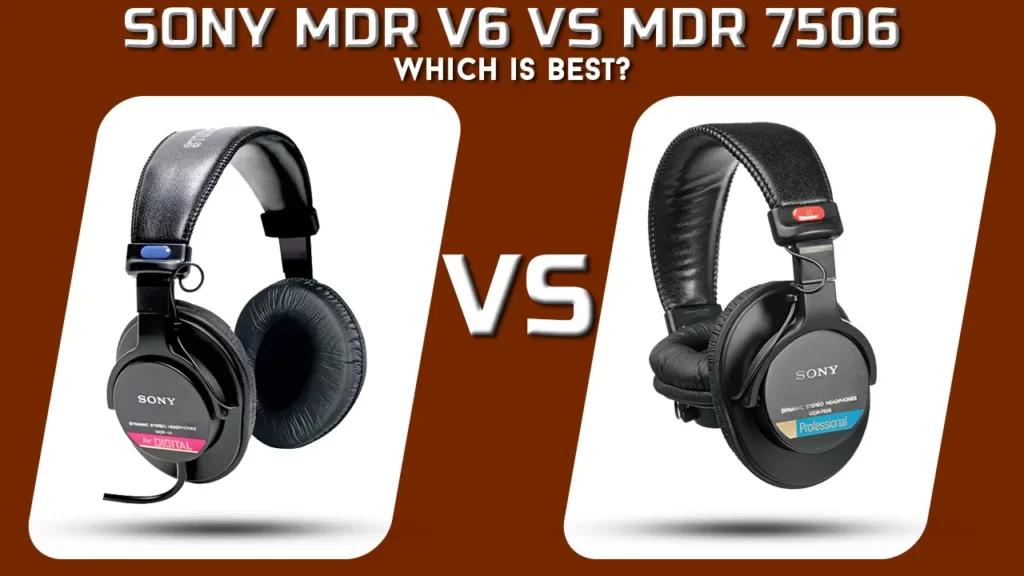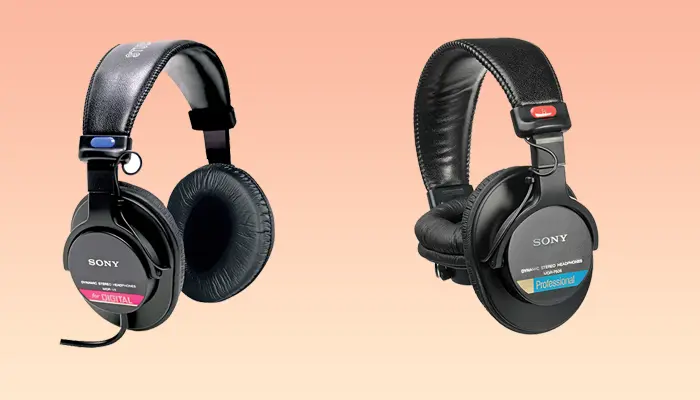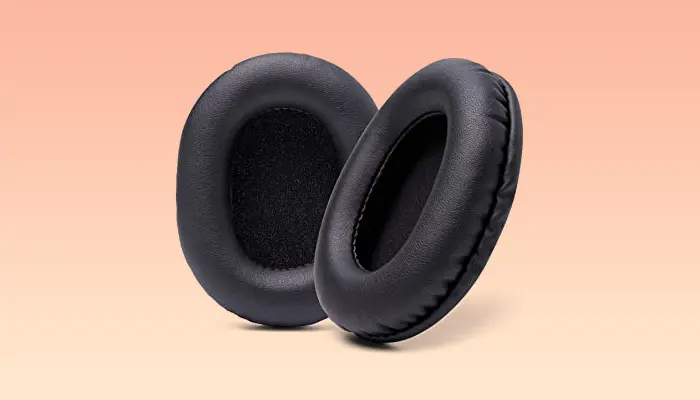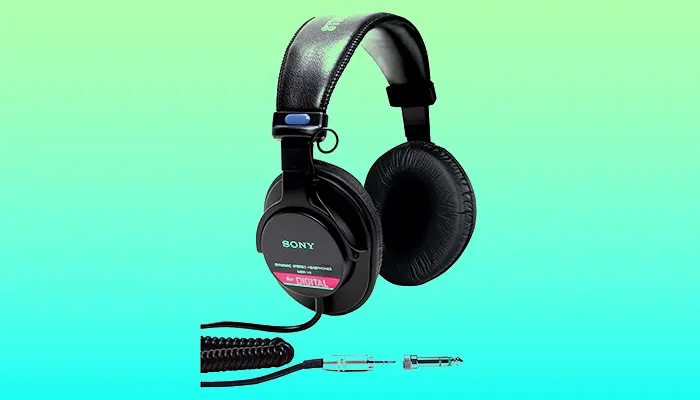The Sony MDR V6 and the Sony MDR 7506 are classic headphones from the mid-1980s. The MDR V6 was announced in 1985 and the MDR 7506 was announced in 1991. MDR stands for Micro Dynamic Reciever trademark and these were premium quality headphones from Sony in their time and are still in use after 3 and a half decades. Let us compare Sony MDR V6 vs MDR 7506 and see which turns out to be the best.

Design

The Sony MDR V6 and the Sony MDR 7506 are foldable headphones, ahead of their generation. Despite releasing in the mid-1980s they still hail industry-standard audio quality. We measured both pairs and they were of decent weight, just 0.5 pounds without the cable. They are classics in the audio industry and we can feel that in the packaging. The box contains a pair of headphones, a 3.5mm audio jack to a 1/4″ convertor, and a carrying pouch.
The headphones have vinyl earpads which are nicely gripped but can certainly leak audio while listening. The foam on the drivers is of decent quality. Remember the vinyl earpads can shred out after some time because these are not some high-notch leather, so be careful not to scratch them with your nails. The headband has a decent rubber material for sitting on the skull but not too much. You might feel the inner structure after some time. The headphones feel solid though, you will get a premium feeling when you hold them. They stayed on our heads intact despite heavy disturbances, which is noteworthy to say.

The headphones can also be carried easily because of their foldable structure and also the pouch that ships with it can be used to store them. The headphones are made up of black anodized aluminum, which means you don’t have to worry about their durability. Even the foldable hinge is solid. The earcups on the Sony MDR V6 and the Sony MDR 7506 are rotatable and you can use them when you just want to hear audio from one earcup rather than both or you can rotate the earcups outside and rest them on your shoulders.
Sony has designed the headphones in a way that a consumer can easily replace parts. It is certainly hard to find these parts in the market, but if you find them they are really easy to replace. You need the right screwdriver for your work. The earpads can wear out after some time but you can easily find those in any online marketplace and it is very easy to change. The Sony MDR V6 and the Sony MDR 7506 are both identical despite the V6 having “For Digital” written in red on their earcups while the 7506 has “Professional” written in blue on their earcups.
Connection

The Sony MDR V6 and the Sony MDR 7506 are both wired and use a 3m long wire for audio transmission. The cable is durable and coiled. The long cable makes portability easier and can straighten up when you need them. The audio jacks are all metal and you also get a 3.5m jack to 1/4″ converter for using with professional gear. We connected the headphones to the smartphone, PC, laptop, tablet, and any other electronic device that needs a 3.5mm audio jack and they worked fine.
The wire is pretty heavy though because of its length and they are a bit thicker than today’s audio wires. I have to say because of their all-metal audio jack we noticed that the wire does not wears out at the junction as it usually does with newer audio cables. Both the Sony MDR V6 and the Sony MDR 7506, have the same cable.
Sound
The isolation provided by the rubber earpads is decent and works well in blocking ambient sound. We noticed as we were wearing the headphones we were not able to listen outdoors to a great extent. Screeching noises can still be heard, which means lows are not blocked as nicely as highs. Well, this is understandable because these headphones don’t offer Active Noise Cancellation, which can be easily found in today’s over-the-ear headphones.
The sound that the Sony MRD V6 as well as the Sony MDR 7506 produced was very loud, peak loudness can go up to 133 dB which is insane because loudness over the 115 dB mark can cause immediate and permanent hearing loss. Be careful not to increase the volume by more than 50% while using these headphones. And also don’t use any extra amp because it won’t be required for these headphones.
The frequency ranges of the two headphones are not the same. The Sony MDR V6 has a dynamic frequency range of 5 ~ 30,000 Hz which is huge compared to today’s consumer headphones and the Sony MDR 7506 has a dynamic frequency range of 10 ~ 20,000 Hz which is the same as compared to today’s headphones.
The driver on both headphones is 40mm in diameter and is responsible for great sound and bass. The bass performance is not great because of some audio leakage from the rubberized earpads but they are not bad though. The magnets used in the two are different – the V6 uses samarium-cobalt magnets while the 7506 uses neodymium magnets, the latter is used in most headphones and offers much better quality sound. The driver is rather the same, but the change in magnets causes a slight change in the sound response.
The sound response on the V6 is balanced while the 7506 produces more mids and highs. The bass level on the 7506 is very low compared to the V6. The Sony MDR 7506 is particularly for audio technicians because it helps in sensing more noise, which is required in music editing.
With different EQ software nowadays, you can easily increase the bass level on both headphones and make them sound like any other headphones. But, I will say the V6 is for music junkies and audiophiles who want to enjoy their music.
Sony MDR V6 vs MDR 7506 – The Verdict
The Sony MDR V6 and the Sony MDR 7506 are almost identical – remember the 7506 has “Professional” written in blue rather than “For Digital” in red as in the V6.
The 7506 also captures more noise so that you can correct them in the post-music production. The Sony MDR 7506 also has less bass response. And both the headphones are pretty loud and clear.
If you are an audiophile and don’t notice the minimal problems in the audio then the Sony MDR V6 can be a great pair of classic headphones for you. You get to use a headphone that has survived for more than 3 and a half decade and also enjoy the unbeatable sound. But Sony has discontinued its production so the price may be high.
If you are starting out your music career or introducing yourself in the audio professionals’ sphere then the Sony MDR 7506 is a great pair for you.
For more such reviews, check out our website: JBL charge 5 vs Bose Soundlink Flex – Which Should You Buy?
Frequently Asked Questions
Is MDR V6 discontinued?
The MDR V6 was discontinued after 2020, the MDR 7506 is still in production.
Does Sony MDR 7506 have bass?
The Sony MDR 7506 has low bass response as compared to most headphones. The 7506 is pretty good in the mids and highs.
Is Sony MDR 7506 good for mixing?
The 7506 is absolutely good for mixing because it has a great frequency response and sensitivity to noise.